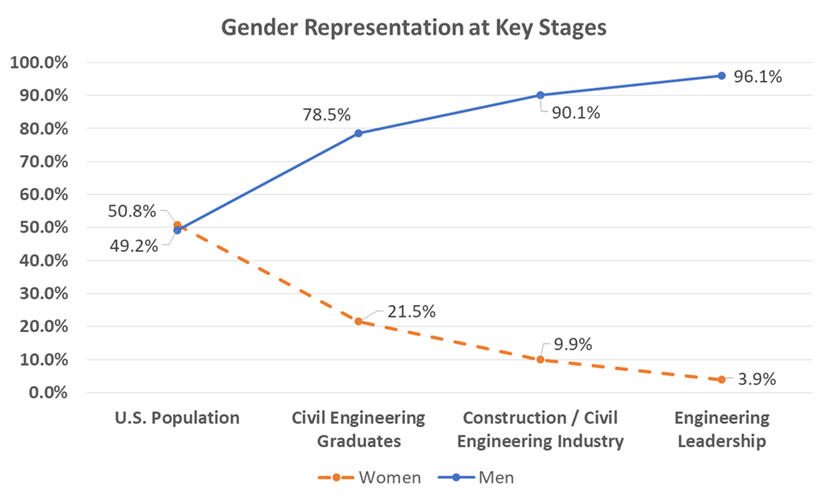THE EVIDENCE
Evidence suggests that increasing women’s participation on executive teams leads to value through fresh perspective and ideas, enhanced relationships with stakeholders, higher innovation, greater creativity, and a better bottom line. Concurrently, Architecture, Engineering, and Construction (AEC) industry faces labor shortages due to looming retirements of half the workforce. U.S. Department of Labor reported women fill 9.9% of all industry positions in 2019 (since increased to 10.9% in 2020). Since women comprise 50.8% of the U.S. population, the field effectively excludes half of the potential current and future workforce.
EXECUTIVE TEAM COMPOSITION
This study quantified executive team gender composition of the largest AEC firms. Using industry recognized 2018 Engineering News Record (ENR) Top 400 civil engineering and construction firms listing, researchers extracted leadership information from the company self-published websites, subdividing women and men into engineering and non-engineering (e.g., finance and marketing) billets. Overall, researchers found that women fill only 3.9% of executive engineering billets (decreased to 3.5% in 2020).
MEN DOMINATE THE AEC EXECUTIVE SUITES
Confirming the previously held anecdotal perception that men dominate the AEC executive suites, this study offers a state of practice assessment of the industry. Active recruitment and expansion of women’s membership, highlighted by middle, senior, and executive management offers potential solutions to address workforce shortages and improve business outcomes. Fundamental changes highlighted by firms publicly promoting inclusion and altering recruiting methods promise to create more diverse environments. In addition, review of successful segments currently showing higher diversity totals likely gleans additional insights for new training programs and policy changes. Ultimately, underlying factors deterring women from joining or remaining in the field: male dominated culture, conflict and aggression, slow advancement compared to male peers, and work family balance must be addressed. Recommended actions to reverse the trend: active executive engagement, equal opportunities for key positions, and directed mentoring.


[1] Paul Hickey PhD, Department of Civil and Environmental Engineering, University of Maryland, College Park, MD 20740;
[1] Professor, Department of Civil and Environmental Engineering, University of Maryland, College Park, MD 20740; PH (301) 405-8104; email: [email protected] (Corresponding Author)
Reasons Why You Might Need To Apply For A Business Loan
You can use small business loans to raise money to address demands, such as paying unforeseen costs, new equipment, or financing expansion.
5 Proven Tips to Help You Grow a Successful Business
When it comes to growing a successful business, customer satisfaction should always be your number one priority.
A Guide to a More Productive and Better Work Canteen
When creating the canteen area, you should also have some elements of fun that employees can use in relieving their stress.
How to Make Your Business Visible Through Search Engine Optimization
When it comes to making your business visible online, search engine optimization (SEO) is key. Optimize your website for search engines.




